
Üsküdar is a municipality and district of Istanbul Province, Turkey. Its area is 35 km2, and its population is 524,452 (2022). It is a large and densely populated district on the Anatolian (Asian) shore of the Bosphorus. It is bordered to the north by Beykoz, to the east by Ümraniye, to the southeast by Ataşehir and to the south by Kadıköy; with Karaköy, Kabataş, Beşiktaş, and the historic Sarayburnu quarter of Fatih facing it on the opposite shore to the west. Üsküdar has been a conservative cultural center of the Anatolian side of Istanbul since Ottoman times with its landmark as well as numerous tiny mosques and dergahs.

The Tanzimat was a period of reform in the Ottoman Empire that began with the Gülhane Edict in 1839 and ended with the First Constitutional Era in 1876. The Tanzimat era began with the purpose not of radical transformation, but of modernization, desiring to consolidate the social and political foundations of the Ottoman Empire. It was characterised by various attempts to modernise the Ottoman Empire and to secure its territorial integrity against internal nationalist movements and external aggressive powers. The reforms encouraged Ottomanism among the diverse ethnic groups of the Empire and attempted to stem the rise of nationalism in the Ottoman Empire.

The Turkish War of Independence was a series of military campaigns and a revolution waged by the Turkish National Movement, after the Ottoman Empire was occupied and partitioned following its defeat in World War I. The conflict was between the Turkish Nationalists against Allied and separatist forces over the application of Wilsonian principles, especially self-determination, in post-World War I Anatolia and eastern Thrace. The revolution concluded the collapse of the Ottoman Empire; ended of the Ottoman sultanate and Ottoman caliphate, and established the Republic of Turkey. This resulted in the transfer of sovereignty from the sultan-caliph to the nation, setting the stage for nationalist revolutionary reform in Republican Turkey.

Mimar Sinan also known as Koca Mi'mâr Sinân Âğâ, was the chief Ottoman architect, engineer and mathematician for sultans Suleiman the Magnificent, Selim II and Murad III. He was responsible for the construction of more than 300 major structures, including the Selimiye Mosque in Edirne, the Kanuni Sultan Suleiman Bridge in Büyükçekmece, and the Mehmed Paša Sokolović Bridge in Višegrad, as well as other more modest projects such as madrasa's, külliyes, and bridges. His apprentices would later design the Sultan Ahmed Mosque in Istanbul and the Stari Most bridge in Mostar.

In the late 18th century, the Ottoman Empire faced threats on numerous frontiers from multiple industrialised European powers. In response, the empire initiated a period of internal reform, attempting to bring itself into competition with the expanding West. The period of these reforms is known as the Tanzimat, and led to the end of the Old Regime period. Despite the Ottoman empire's precarious international position, the central state was significantly strengthened. The process of reforming and modernization in the empire began with the declaration of the Nizam-I Cedid during the reign of Sultan Selim III and was punctuated by several reform decrees, such as the Hatt-ı Şerif of Gülhane in 1839 and the Hatt-ı Hümayun in 1856. Over the course of the 19th century, the Ottoman state became increasingly powerful and rationalized, exercising a greater degree of influence over its population than in any previous era.
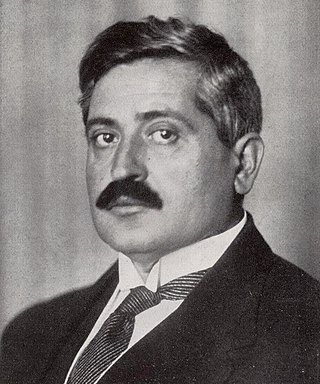
Mehmed Talaat, commonly known as Talaat Pasha or Talat Pasha, was an Ottoman Young Turk activist, politician, and convicted war criminal who served as the de facto leader of the Ottoman Empire from 1913 to 1918. He was chairman of the Union and Progress Party, which operated a one-party dictatorship in the Empire; during World War I he became Grand Vizier. He has been called the architect of the Armenian genocide, and was responsible for other ethnic cleansings during his time as Minister of Interior Affairs.
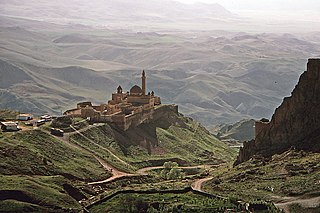
Ishak Pasha Palace is a semi-ruined palace and administrative complex located in the Doğubeyazıt district of Ağrı province of eastern Turkey.
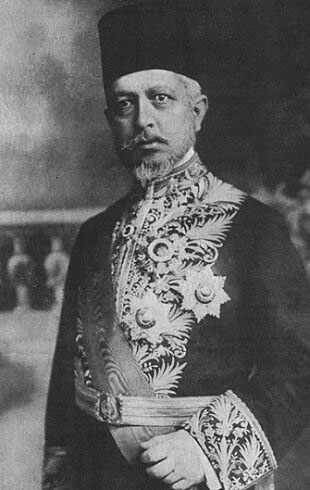
Mehmed Said Halim Pasha was a was a statesman who served as the Grand Vizier of the Ottoman Empire from 1913 to 1917. He was one of the perpetrators of the Armenian genocide and later assassinated by Arshavir Shirakian as part of Operation Nemesis, a retribution campaign to kill perpetrators of the Armenian genocide.

Ahmed Rıza was an Ottoman educator, activist, revolutionary, intellectual, politician, polymath, and a prominent member of the Young Turks. He was also a key early leader of the Committee of Union and Progress.

Hagop Kazazian Pasha (1836–1891) was a high-ranking Ottoman Armenian official, who served as the Minister of Finance and the Minister of the Privy Treasury during the reign of Sultan Abdul Hamid II. Famed at the time for his loyalty, he received a state funeral after he died in 1891 from a horse-riding accident on the grounds of Kalender Kasrı while riding a horse that had been a gift from the sultan.

Damat Mehmed Adil Ferid Pasha, known simply as Damat Ferid Pasha, was an Ottoman liberal statesman, who held the office of Grand Vizier, the de facto prime minister of the Ottoman Empire, during two periods under the reign of the last Ottoman Sultan Mehmed VI, the first time between 4 March 1919 and 2 October 1919 and the second time between 5 April 1920 and 21 October 1920. Officially, he was brought to the office a total of five times, since his cabinets were recurrently dismissed under various pressures and he had to present new ones. Because of his involvement in the Treaty of Sèvres, his collaboration with the occupying Allied powers, and his readiness to acknowledge atrocities against the Armenians, he was declared a traitor and subsequently a persona non grata in Turkey. He emigrated to Europe at the end of the Greco-Turkish War.

Ahmed Izzet Pasha, known as Ahmet İzzet Furgaç after the Turkish Surname Law of 1934, was an Ottoman general during World War I. He was also one of the last Grand Viziers of the Ottoman Empire and its last Minister of Foreign Affairs.

Wehib Pasha also known as Vehip Pasha, Mehmed Wehib Pasha, Mehmet Vehip Pasha, was a general in the Ottoman Army. He fought in the Balkan Wars and in several theatres of World War I. In his later years, Vehib Pasha volunteered to serve as a military advisor to the Ethiopian Army against Fascist Italy during the Second Italo-Ethiopian War. He served as the chief of staff to Nasibu Zeamanuel, the Ethiopian Commander-in-Chief on the southern front.

The Remaining Documents of Talaat Pasha, also known in Turkey as The Abandoned Documents of Talaat Pasha and Talaat Pasha's Black Book, is the title of a 2008 book by the Turkish journalist Murat Bardakçı. It reproduces in modern Turkish script a selection of documents from the WWI period by Mehmed Talaat Pasha, the Ottoman Empire's Grand Vizier and Minister of Interior, that deal with the relocations of both Muslim Turks and Armenians and the expropriation of abandoned Armenian and Greek property. Its full English title is The Remaining Documents of Talaat Pasha: Documents and Important Correspondence Found in the Private Archives of Sadrazam Talaat Pasha about the Armenian Deportations.

Mehmed Reshid was an Ottoman politician and physician, official of the Committee of Union and Progress, and governor of the Diyarbekir Vilayet (province) of the Ottoman Empire during World War I. He is known for organizing the 1915 genocide of the Armenian and Assyrian communities of Diyarbekir, in which between 144,000 and 157,000 Armenians, Assyrians, and other Christians were killed. During the Allied occupation of Istanbul, Reshid was arrested and his roles in the massacres were exposed. He later escaped from prison, but committed suicide after being cornered by local authorities.

Mehmet Cavit Bey, Mehmed Cavid Bey or Mehmed Djavid Bey was an Ottoman economist, newspaper editor and leading politician during the dissolution period of the Ottoman Empire. As a Young Turk and a member of the Committee of Union and Progress (CUP) had positions in government after the constitution was re-established. In the beginning of the Republican period, he was controversially executed for his alleged involvement in an assassination attempt against Mustafa Kemal Atatürk.
Bayram Pasha was an Ottoman grand vizier from 1637 to 1638 and the Ottoman governor of Egypt from 1626 to 1628.
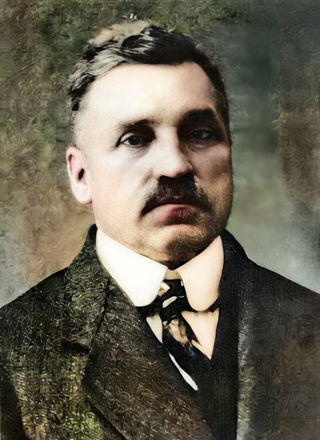
Selanikli Mehmed Nâzım Bey also known as Doktor Nazım was a Turkish physician, politician, and revolutionary. Nazım Bey was a founding member of the Committee of Union and Progress, and served on its central committee for over ten years. He played a significant role in the Armenian genocide and the expulsion of Greeks in Western Anatolia. He was convicted for allegedly conspiring to assassinate Mustafa Kemal Atatürk in İzmir and was hanged in Ankara on 26 August 1926. He also served as the chairman of the Turkish sports club Fenerbahçe S.K. between 1916 and 1918.
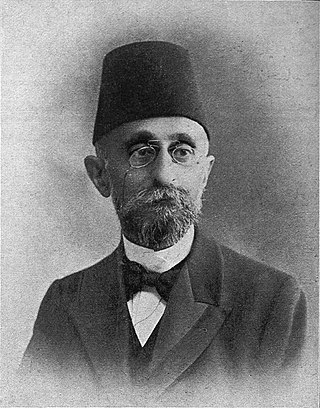
Gabriel (Kapriel) Efendi Noradunkyan was an Ottoman Armenian statesman and bureaucrat. He served as the Minister of Trade in 1908 and Minister of Foreign Affairs of the Ottoman Empire from July 22, 1912 to January 23, 1913 during the reign of Mehmed V and the prime ministership of Ahmed Muhtar Pasha and Kâmil Pasha.

The confiscation of Armenian properties by the Ottoman and Turkish governments involved seizure of the assets, properties and land of the country's Armenian community. Starting with the Hamidian massacres and peaking during the Armenian genocide, the confiscation of the Armenian property lasted continuously until 1974. Much of the confiscations during the Armenian genocide were made after the Armenians were deported into the Syrian Desert with the government declaring their goods and assets left behind as "abandoned". Virtually all properties owned by Armenians living in their ancestral homeland in Western Armenia were confiscated and later distributed among the local Muslim population.
















